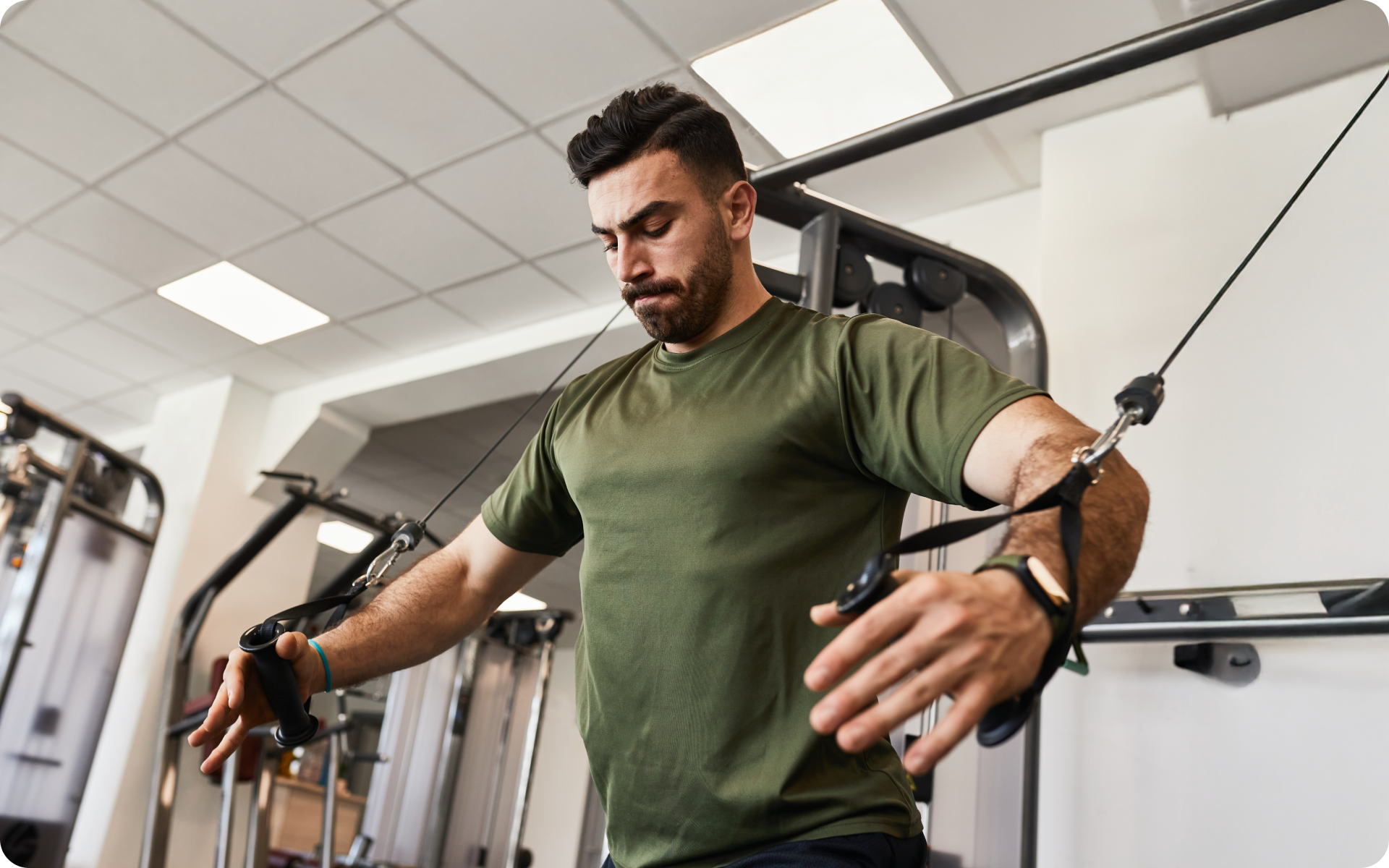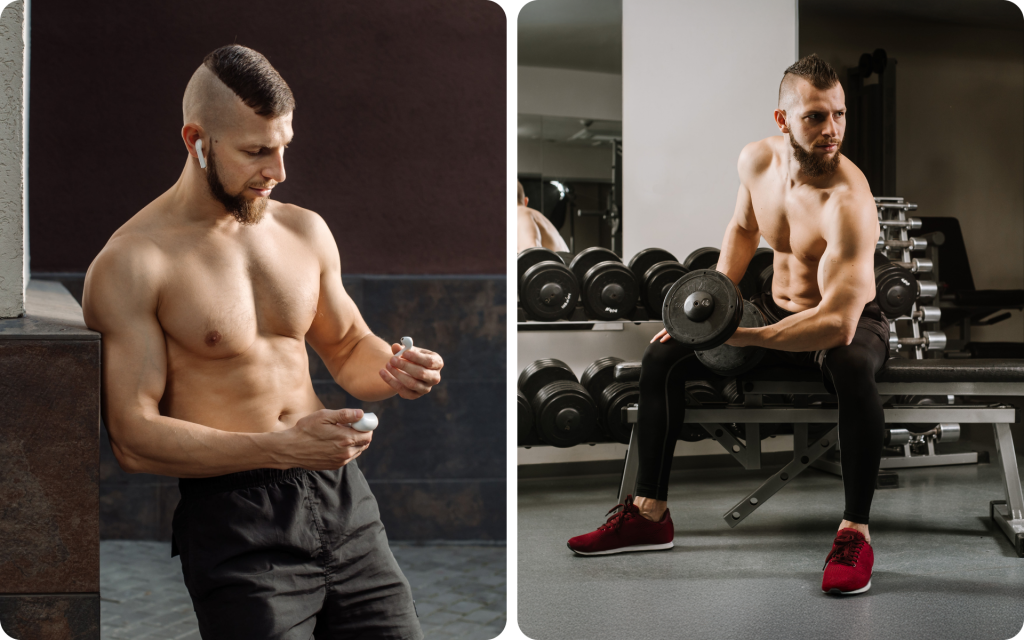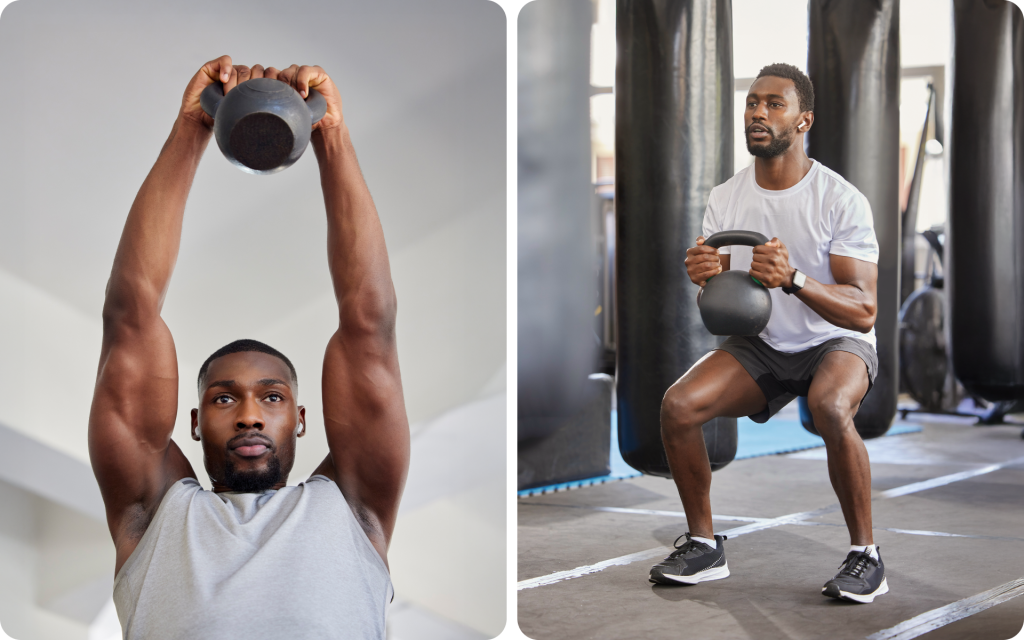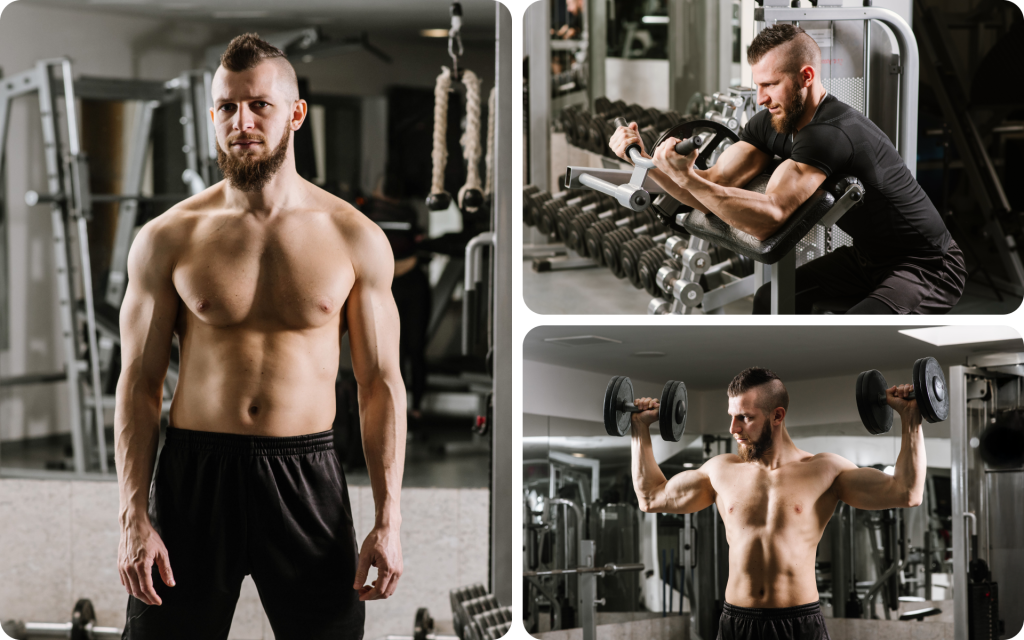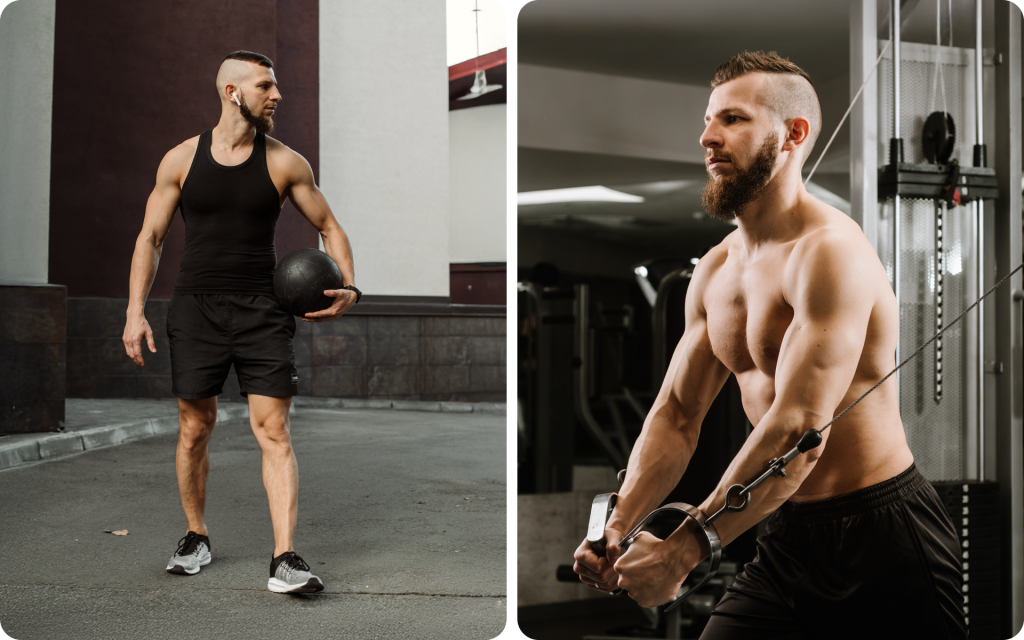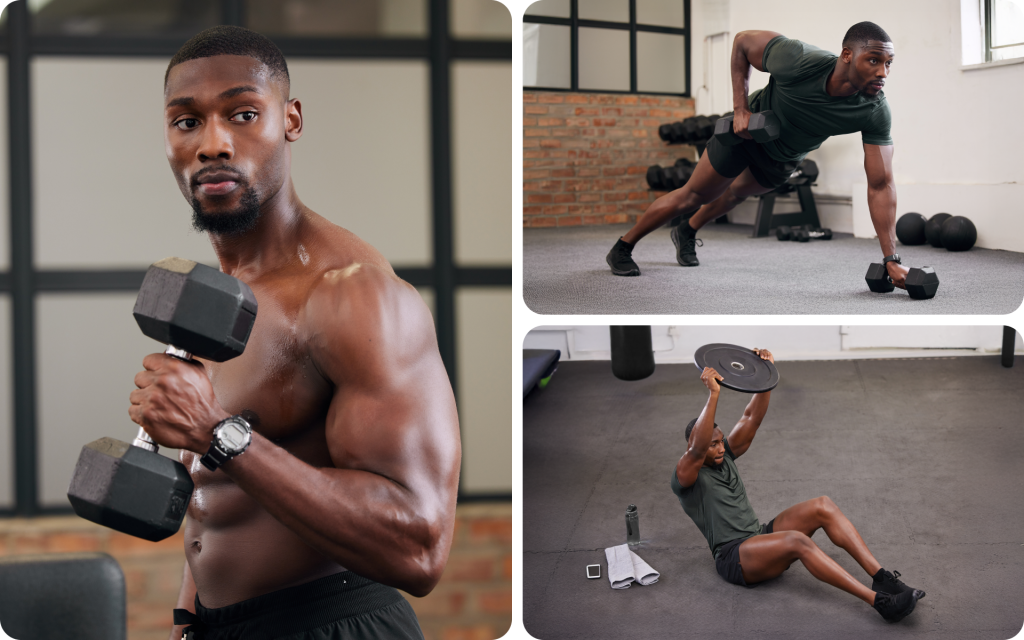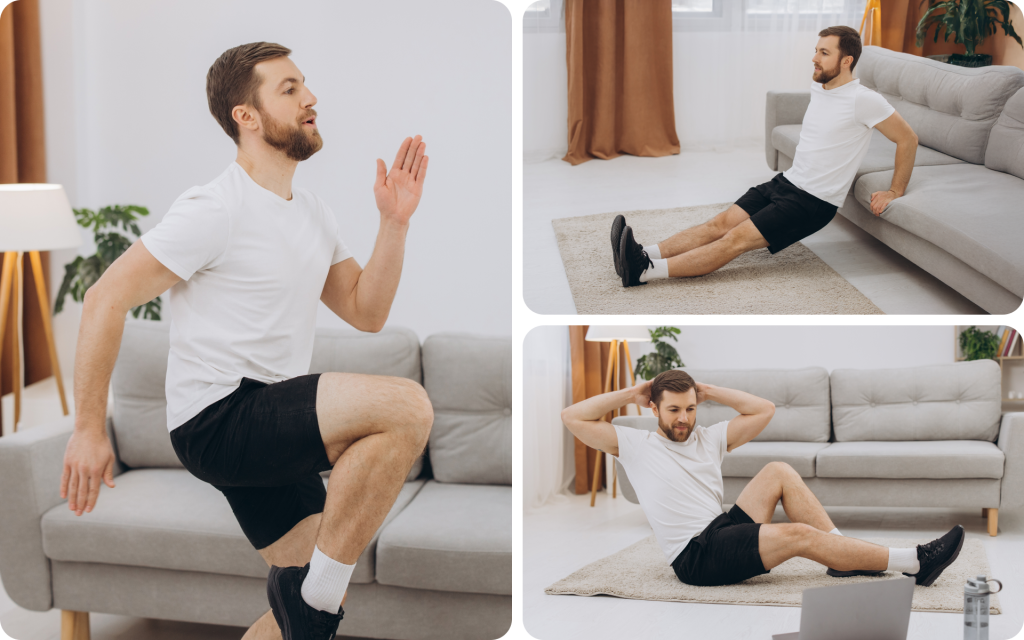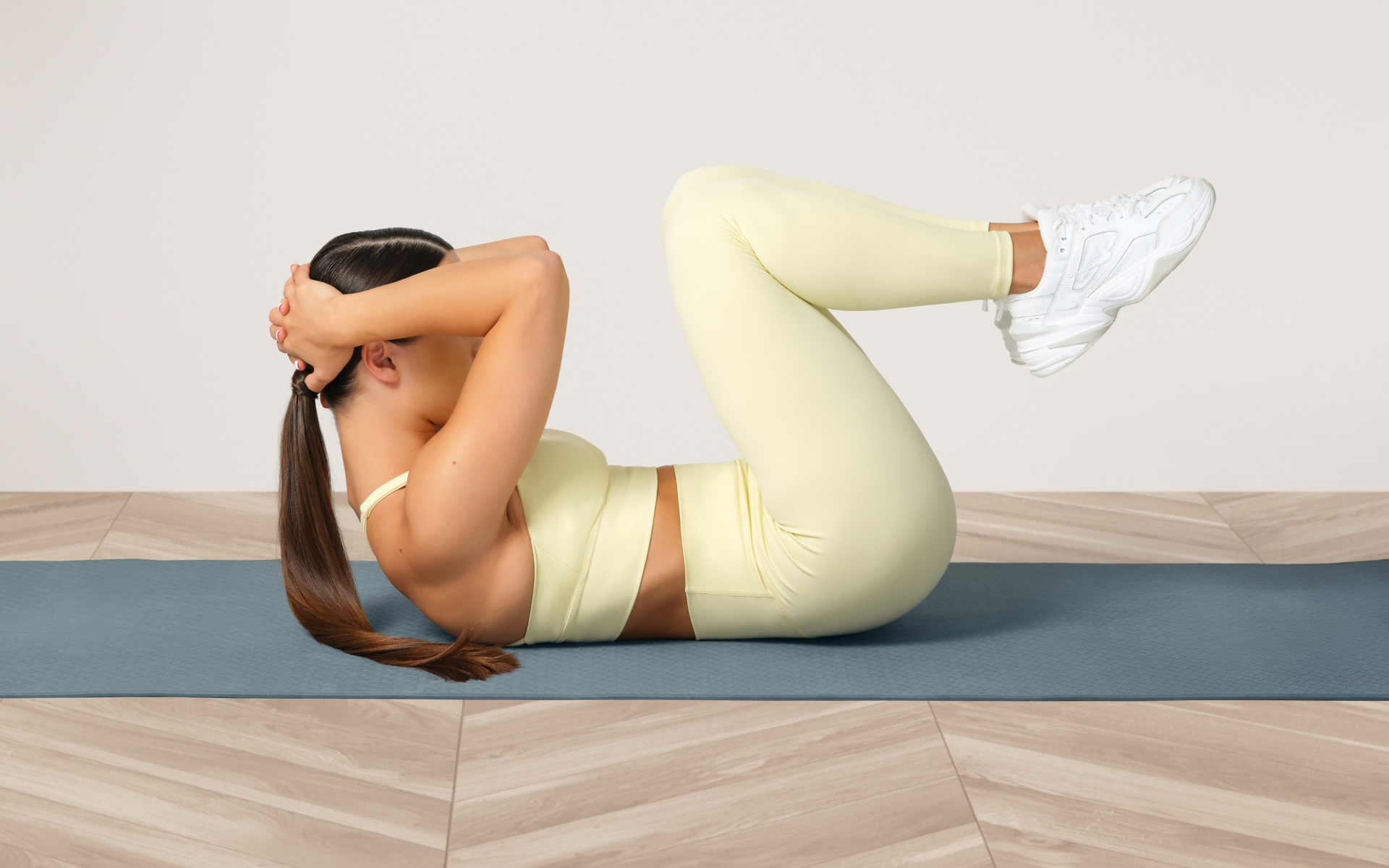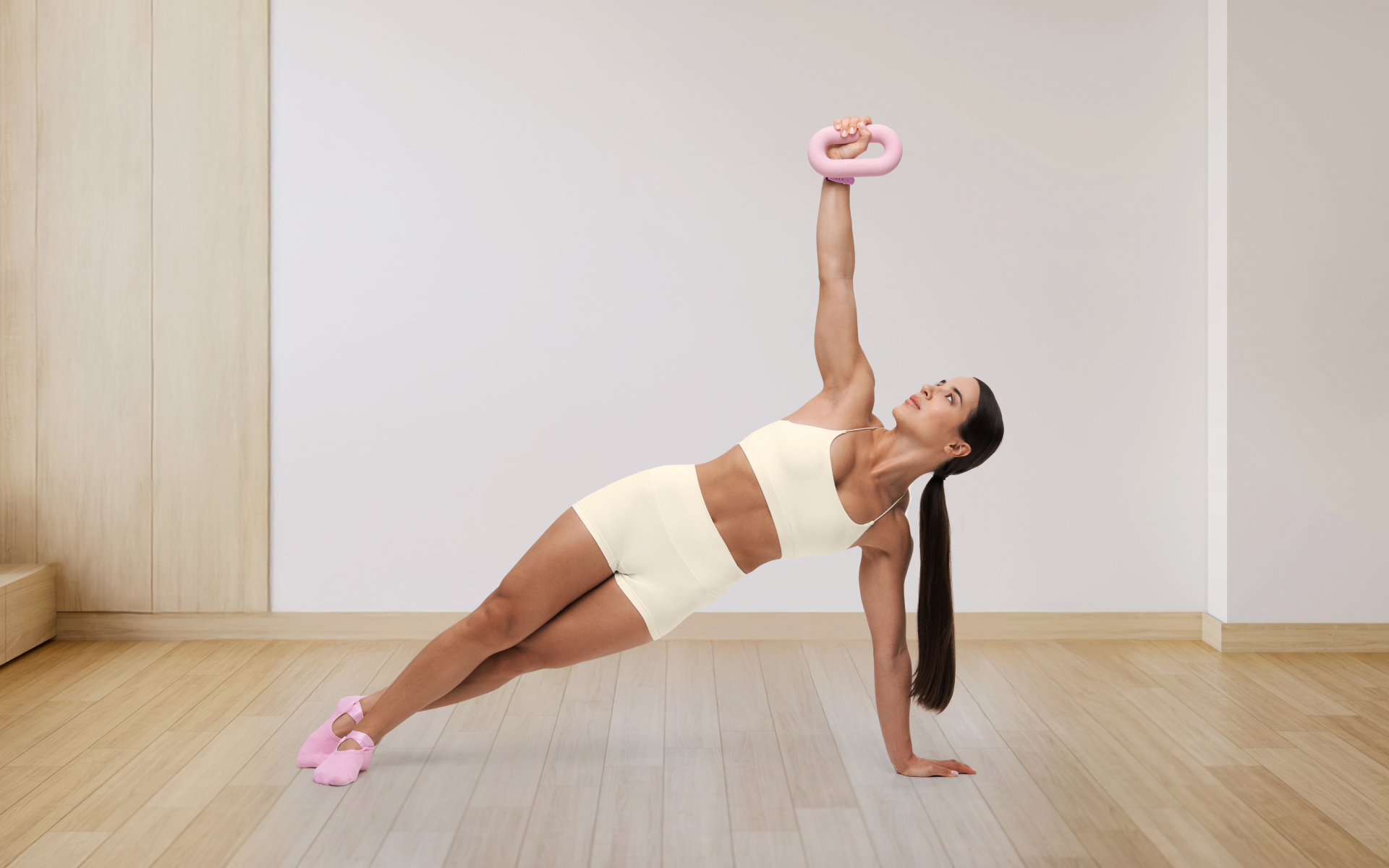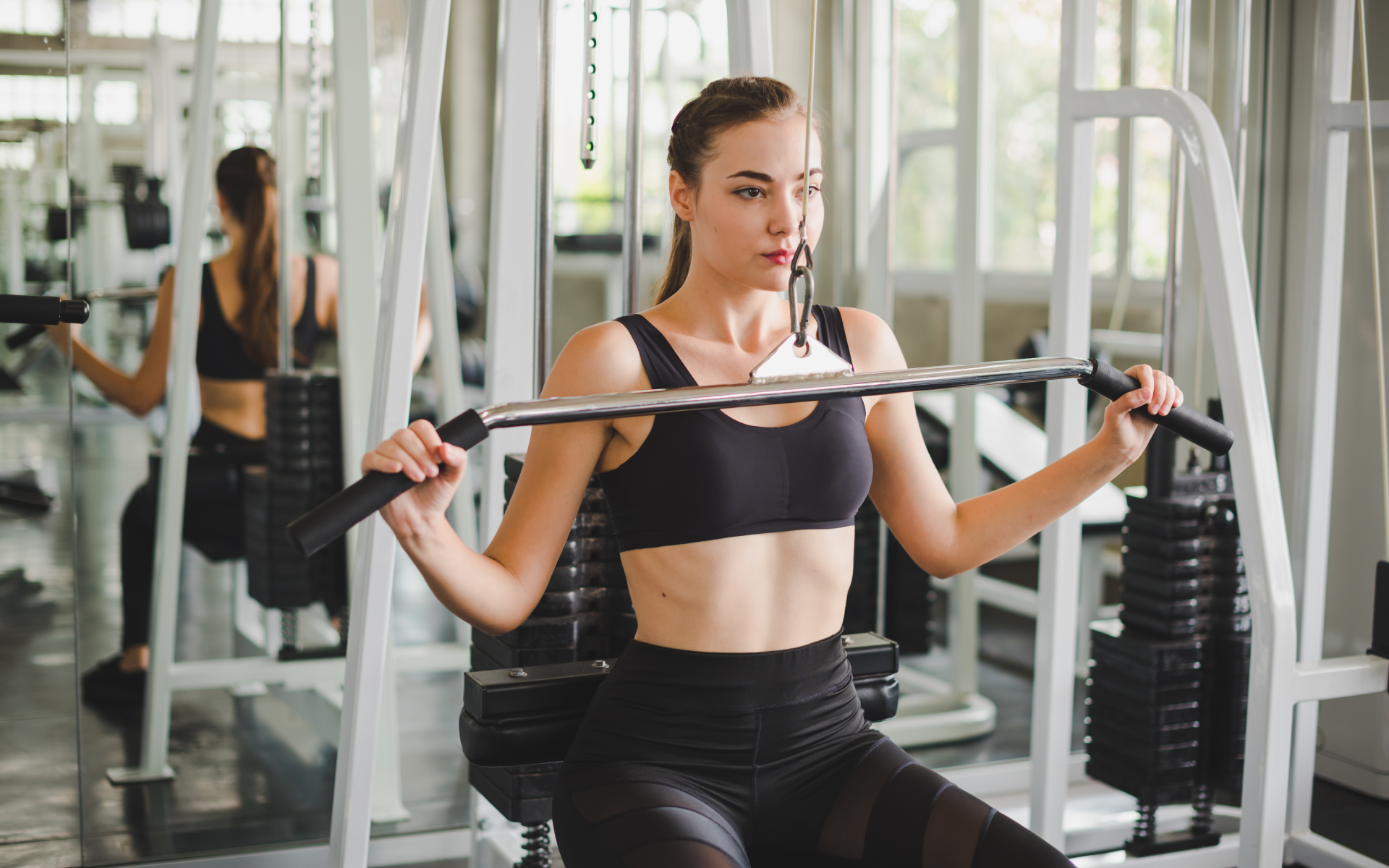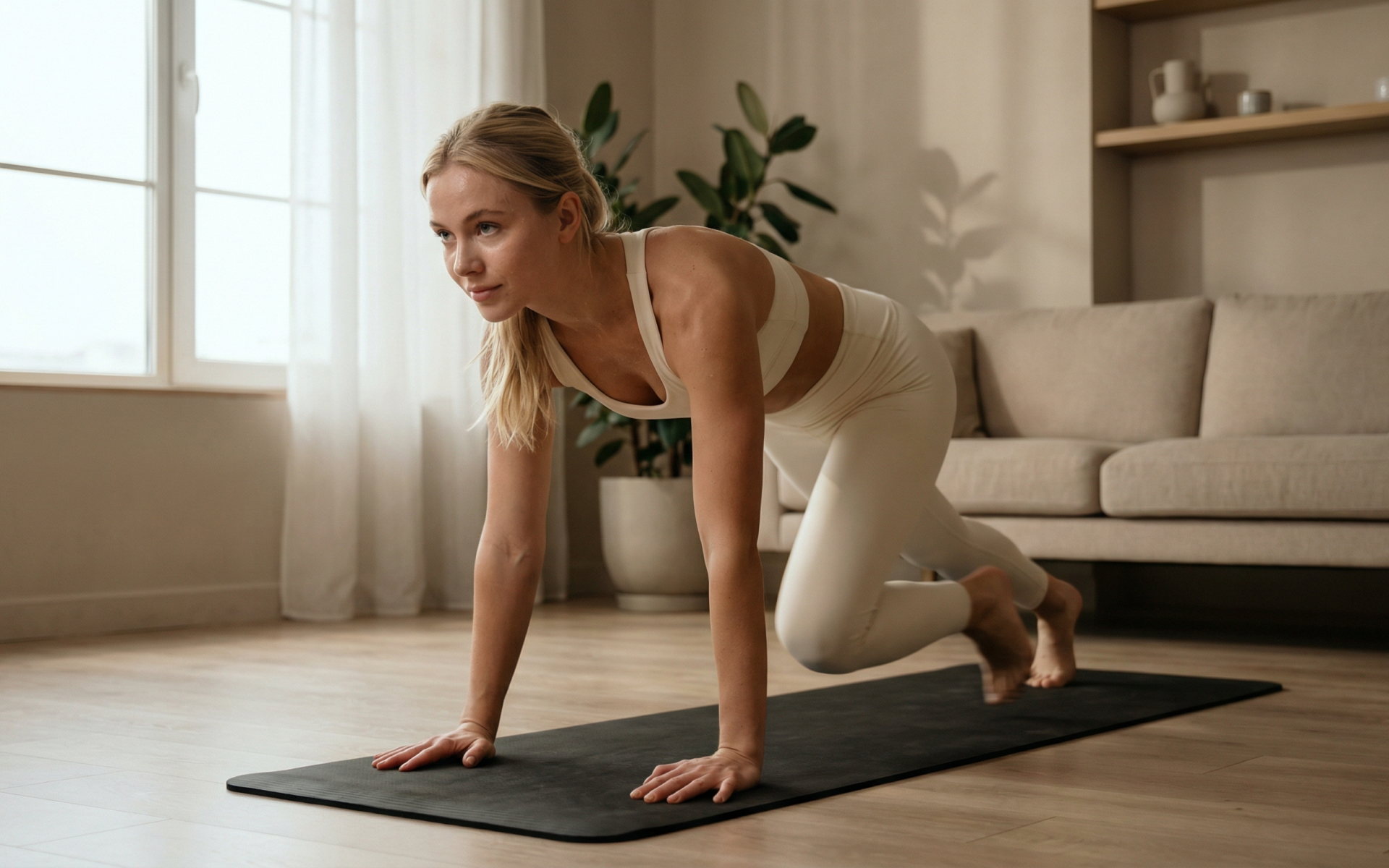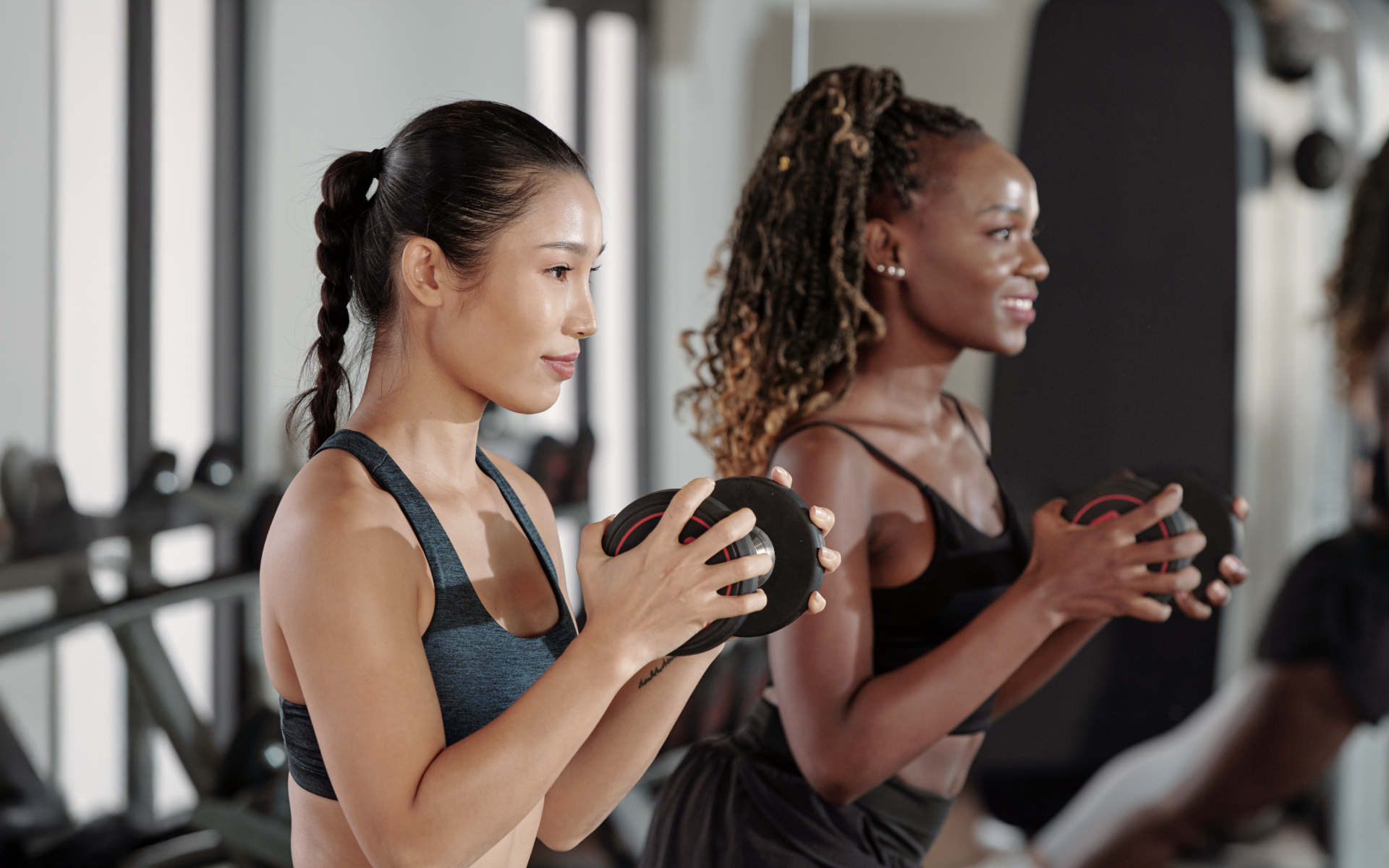The chest, which is primarily composed of the pectoralis major and minor, provides the force for horizontal pressing, while the triceps brachii, which is located on the back of the upper arm, extends the elbow to complete the movement (1).
Together, they create a dynamic duo that enhances upper body aesthetics and supports athletic performance and daily functionality.
In this guide, we’ll explore the science behind training these muscles effectively, focusing on exercises, techniques, and strategies to maximize strength, hypertrophy, and injury prevention.
Can I Train Chest and Triceps on the Same Day?
Yes, you can. By training chest and triceps together, you align your workout with how the body naturally functions during pressing movements, capitalize on neurological and muscular adaptations, and better manage your time and recovery throughout the week.
A chest and triceps workout unlocks these benefits:
- Enhanced Neuromuscular Coordination
Training the chest and triceps together leverages the fact that these muscle groups are primary movers and synergists during pressing exercises (2). When you perform a bench press or push-up, your chest initiates the movement, while your triceps assist with elbow extension.
By training both in a single session, you reinforce movement patterns and intermuscular coordination. This strengthens neural pathways that make your pressing actions more efficient, which provides both immediate performance benefits and long-term improvements in movement economy (3).
- Maximized Training Efficiency
Pairing chest and triceps in one workout allows you to target related muscle groups in sequence, which reduces the need for excessive warm-up sets and minimizes redundant exercises.
After challenging your chest, your triceps are already pre-activated, which permits a more streamlined transition into isolation movements such as triceps push-downs or overhead extensions. This structure is time-efficient and ensures that the acute fatigue experienced in the triceps doesn’t inhibit performance on compound chest lifts, as those are trained first with greater strength reserves.
- Optimal Muscle Fatigue and Growth Stimulus
Scientifically, muscles that are pre-fatigued – such as the triceps following chest work – respond to isolation exercises with a more pronounced metabolic and hypertrophic stimulus. By capitalizing on this cumulative fatigue, you can promote muscle growth through increased time under tension and metabolic stress, both recognized components of hypertrophy (4).
For individuals who are aiming for muscular development, this approach ensures that the triceps receive sufficient direct loading without requiring additional separate training days.
- Improved Recovery Management
Structuring your weekly workout split to include chest and triceps on the same day opens additional recovery windows for other muscle groups.
This method enables you to optimize your overall training frequency and reduce overlapping muscle soreness, particularly in muscle groups that may otherwise be taxed in multiple sessions.
For athletes and high performers who are managing busy schedules or multiple physical demands, this structure can enhance total body recovery and reduce the risk of overuse injuries.
When it comes to weight loss, progress is made by inches, not miles, so it’s much harder to track and a lot easier to give up. The BetterMe: Health Coaching app is your personal trainer, nutritionist, and support system all in one. Start using our app to stay on track and hold yourself accountable!
- Streamlined Focus for Performance Goals
Combining chest and triceps training allows for clarity in workout intent – both muscle groups are dedicated to pressing and pushing mechanics (2). This single-session focus supports goal-oriented programming, whether you’re aiming for strength, endurance, or hypertrophy.
It also simplifies training for those balancing fitness with work or rehabilitation, offering evidence-based structure while accommodating diverse life demands.
Read more: Men’s Calisthenics Workout: 8 Exercises to Build a Lean Physique
Should I Hit Chest or Triceps First?
The order in which you train chest and triceps can make a meaningful difference in your results, depending on your goals and current training status. Traditionally, most individuals train chest before triceps. This sequencing is effective for several reasons.
When you train your chest first, your triceps are fresh and able to support the demands of heavy compound movements such as the bench press or incline press.
The chest exercises will recruit the triceps as synergistic muscles, which means your triceps will still be trained, but without being pre-fatigued, ensuring your performance and safety during heavy lifts. This approach is particularly useful if your primary goal is to maximize chest strength and size.
On the other hand, if your priority is to bring up your tricep development, or if you’re working around a specific chest limitation or injury, starting with triceps can make sense. Training triceps first pre-fatigues them, which can increase the intensity of triceps isolation but will likely decrease pressing strength on subsequent chest movements. Uncover the surprising benefits of calisthenics chest in our past article.
This method is sometimes used in strategic programming for advanced athletes or rehabilitation contexts, where targeted muscle recruitment takes precedence over maximal lifting.
Importantly, the nervous system adapts most efficiently to the first few exercises of any session. Whether you choose to lead with chest or triceps, that muscle group will receive the highest quality work. Consider your personal goals, any technical limitations, and how your body feels on training day.
In short, for most lifters – particularly those who are aiming for balanced upper body strength – starting with the chest is optimal. However, both orders have their place, and the best approach is to align your training sequence with your specific objectives and recovery needs.
How to Train Chest and Triceps Together
Understand the Role of Each Muscle Group
The chest (pectoralis major and minor) and triceps brachii often work synergistically during pressing movements (2). Knowing their functions – chest driving horizontal adduction and triceps extending the elbow – helps in selecting exercises that offer overlap while also isolating each group as needed.
Choose Compound Movements as Your Foundation
Start your session with compound lifts that target both muscle groups, such as the bench press, push-ups, or dips. These exercises provide the greatest training stimulus, recruiting high-threshold motor units while allowing you to move heavier loads when your energy and neural drive are highest (5).
Sequence Isolation Exercises Efficiently
After compound movements, integrate isolation exercises to address specific muscle deficits and facilitate complete fatigue. Cable flyes or dumbbell flyes emphasize the chest, while triceps push-downs or overhead extensions isolate the triceps. This approach ensures each muscle is adequately challenged.
Regulate Training Volume and Intensity
Balance your volume (sets and reps) and intensity (load) to match your goals – be it hypertrophy, strength, or endurance. Research supports 8-20 working sets per muscle group per week as effective for most lifters (6), with 6-12 repetitions per set being a proven range for muscle growth (7). Adjust these variables based on your current training status and recovery capacity.
Monitor Technique and Mind-Muscle Connection
Maintain precise form throughout, as technique degradation increases the risk of injury and reduces training efficiency (8). Employ deliberate tempo and focus on the mind-muscle connection, particularly in later sets when neural fatigue can impair motor control (9).
Plan for Recovery and Progression
Adequate rest is essential, both between sets and sessions. Allow at least 48-72 hours before you train the same muscle groups again (10). Build your program with progressive overload in mind, gradually increasing demand through load, volume, or exercise variation as you adapt (11).
Adapt to Your Unique Context
Every lifter’s anatomy, recovery profile, and performance goals differ. Stay attentive to how your body responds to exercise selection, order, and weekly frequency, and be prepared to tailor your approach accordingly for sustainable gains and injury prevention.
Remember, a Good Chest and Arm Workout can make all the difference—helping you develop upper-body strength, improve muscle symmetry, and boost overall performance with focused, time-efficient training.
What Is a Good Chest and Triceps Workout at the Gym?
Warm-Up: Preparing Body and Brain
A thorough warm-up primes both the musculoskeletal and nervous systems for the demands ahead. Start with 5-10 minutes of light cardio (rowing, treadmill walking, or cycling). Follow with dynamic upper body movements such as arm circles, band pull-aparts, and light push-ups. This increases blood flow, activates stabilizing muscles, and enhances the mind-muscle connection (12).
Compound Movements: Building Strength and Efficiency
Start your main session with a compound chest exercise to maximize overall upper-body engagement.
Examples:
- Barbell bench press: 3-4 sets of 6-8 reps
- Dumbbell bench press: 3-4 sets of 8-10 reps
- Incline bench press: 3 sets of 8-10 reps
These lifts engage both chest and triceps, in addition to the supporting muscles. Focus on controlled form and a moderate tempo.
Isolation Exercises: Targeted Muscle Activation
After compound lifts, transition to exercises that isolate the chest and triceps.
Chest Isolation:
- Dumbbell flyes: 3 sets of 10-12 reps
- Cable crossovers: 3 sets of 12-15 reps
Triceps Isolation:
- Triceps rope pushdown: 3 sets of 10-12 reps
- Overhead triceps extension: 3 sets of 12-15 reps
This targeted work ensures both muscle groups receive direct training stimulus, complementing their overlap during compound exercises.
Accessory Work and Functional Integration
Consider adding bodyweight movements or stability-based exercises for balanced development.
Options:
- Dips (weighted or bodyweight): 2-3 sets to near failure
- Push-ups (vary grips): 2 sets of 12-20 reps
These moves enhance overall joint health, functional strength, and neuromuscular coordination.
Recovery Strategies: Closing the Loop
Finish your workout with 5-10 minutes of stretching that’s focused on the chest, shoulders, and triceps. Gentle foam rolling can further support fascia health and help with recovery. Hydrate well and incorporate sufficient protein intake post-session to optimize muscle repair.
Exercise Steps
Barbell Bench Press
- Lie flat on a bench with your feet planted firmly on the floor.
- Grip the bar slightly wider than shoulder-width apart.
- Unrack the barbell and hold it above your chest with your arms extended.
- Lower the bar slowly to the middle of your chest, keeping your elbows at a 45-degree angle.
- Press the bar back up to the starting position, fully extending your arms.
- Repeat for desired reps, maintaining steady form throughout.
Dumbbell Bench Press
- Lie flat on a bench and hold a dumbbell in each hand above your chest with your palms facing forward.
- Lower the dumbbells to chest level, with your elbows angled at approximately 45 degrees.
- Press the weights back up, extending your arms without locking your elbows.
- Keep your movements controlled and focus on squeezing the chest at the top.
- Repeat for recommended reps.
Incline Bench Press
- Set the bench to a 30-45 degree incline and lie back with your feet anchored.
- Grip the bar or hold dumbbells above your upper chest, with your arms extended.
- Lower the weight slowly to your upper chest, maintaining control.
- Press up until your arms are fully extended.
- Repeat for the prescribed number of repetitions.
Dumbbell Flyes
- Lie on a flat bench with a dumbbell in each hand, your palms facing each other.
- Start with your arms extended above your chest and your elbows slightly bent.
- Lower your arms in an arc until they’re just below chest level, feeling a stretch across your pecs.
- Bring the weights back up by reversing the arc, keeping the bend in your elbows.
- Avoid banging the dumbbells at the top.
Cable Crossovers
- Stand between two high cable pulleys and grab a handle in each hand.
- Step forward, leaning slightly with a staggered stance.
- With your elbows slightly bent, bring your hands together in front of your chest in a wide arc.
- Squeeze your chest at the peak of the movement, then slowly return to the start.
- Repeat for the desired number of reps, keeping your movements fluid and controlled.
Triceps Rope Push-Down
- Stand facing a cable machine with a rope attachment set at a high level.
- Grab the rope with both hands, with your elbows by your sides.
- Push the rope downward, spreading the ends apart as your arms extend.
- Keep your upper arms stationary and focus on squeezing your triceps.
- Slowly return to the starting position, controlling the weight.
Overhead Triceps Extension
- Stand or sit holding a dumbbell or rope overhead with both hands.
- Keep your elbows close to your head and pointed forward.
- Lower the weight behind your head by bending your elbows.
- Extend your arms back to the starting position, feeling a stretch and contraction in your triceps.
- Repeat for the target number of reps.
Dips (Weighted or Bodyweight)
- Grip parallel bars and support yourself with your arms locked out.
- Lean slightly forward to engage your chest, or stay upright for more triceps focus.
- Lower your body by bending at the elbows until your shoulders are just below your elbows.
- Push yourself back up to the starting position, fully extending your arms.
- Perform controlled reps, avoiding swinging or jerking movements.
Push-Ups
- Place your hands on the floor slightly wider than shoulder-width apart with your feet extended behind.
- Keep your body in a straight line from your head to your heels and make sure your core is engaged.
- Lower your chest toward the floor by bending your elbows to approximately 90 degrees.
- Press through your palms to extend your arms and return to the top.
- Maintain proper alignment and tempo throughout each repetition.
Read more: This Is How A Toned Body For Men Looks Like, According To Science
Are There Any Exercises That Work Both Chest and Triceps at the Gym?
Absolutely. Several key exercises engage both the chest and triceps at the same time, allowing for efficient and effective upper-body training. These movements are particularly valuable for those who are looking to maximize their workout efficiency without compromising on stimulus or results.
Dips
Dips are a classic compound movement that heavily recruit the lower chest and all three heads of the triceps. By leaning slightly forward and keeping your elbows close to your torso, you can place greater emphasis on the chest, while still providing substantial triceps activation. Controlled tempo and full range of motion are important for muscle engagement and joint health.
Close-Grip Bench Press
The close-grip bench press is another powerhouse lift that hits both the pectorals and the triceps. Bringing your hands closer together narrows the pressing angle, increasing the workload on the triceps while the chest supports the movement. This exercise is excellent for building pressing strength and triceps mass and it offers a joint-friendly alternative for those with shoulder sensitivities.
Push-Ups
Push-ups are an accessible bodyweight staple, particularly when they’re performed with a shoulder-width (or narrower) hand placement. They activate the chest as the primary mover while the triceps work to extend the elbows throughout the push. Adjusting hand placement can shift the load – narrower placements engage the triceps more, while standard push-ups provide a balanced stimulus.
Additional Variations
- Decline Push-Ups: Increase triceps demand by elevating the feet, placing the body at a downward angle.
- Weighted Dips: Add resistance to further challenge both muscle groups, ensuring controlled form for safety.
- Diamond Push-Ups: Hands are positioned close together beneath the chest, which accentuates triceps involvement.
It’s generally recommended to train your chest before the triceps. This sequence ensures your triceps are fresh to support compound chest exercises, which reduces fatigue-related form issues. Standard push-ups engage the triceps, but for optimal growth, supplement with more targeted triceps exercises such as dips, close-grip bench presses, or triceps extensions. Training triceps every other day can lead to insufficient recovery. For most individuals, targeting triceps 1-2 times per week with adequate rest supports strength and growth without risking overuse. In our Tricep Calisthenics blog, we’ve broken down bodyweight movements that target all three heads of the triceps. It offers a scalable and accessible approach to building arm strength. The order comes down to personal goals and weekly workout structure. For example, if chest development or pressing strength is your focus, train chest before back in your weekly routine. Both approaches are effective when combined with balanced volume and rest.Frequently Asked Questions
Should I do chest first then triceps?
Are pushups good enough for triceps?
Is it OK to train triceps every other day?
Should I do chest day or back day first?
The Bottom Line
Doing a chest and triceps workout at the gym is a highly effective way to build upper-body strength, improve functional movement, and support total health.
By understanding the close relationship between these muscle groups, structuring workouts with science-backed principles, and prioritizing recovery, you set the foundation for steady progress. The strategies outlined here can guide you as you tailor your gym sessions to meet your unique goals.
DISCLAIMER:
This article is intended for general informational purposes only and does not serve to address individual circumstances. It is not a substitute for professional advice or help and should not be relied on for making any kind of decision-making. Any action taken as a direct or indirect result of the information in this article is entirely at your own risk and is your sole responsibility.
BetterMe, its content staff, and its medical advisors accept no responsibility for inaccuracies, errors, misstatements, inconsistencies, or omissions and specifically disclaim any liability, loss or risk, personal, professional or otherwise, which may be incurred as a consequence, directly or indirectly, of the use and/or application of any content.
You should always seek the advice of your physician or other qualified health provider with any questions you may have regarding a medical condition or your specific situation. Never disregard professional medical advice or delay seeking it because of BetterMe content. If you suspect or think you may have a medical emergency, call your doctor.
SOURCES:
- Muscles of the Pectoral Region (2024, teachmeanatomy.info)
- A comparison of muscle activity and 1-RM strength of three chest-press exercises with different stability requirements (2011, tandfonline.com)
- Functional and/or structural brain changes in response to resistance exercises and resistance training lead to cognitive improvements – a systematic review (2019, eurapa.biomedcentral.com)
- Pre-exhaustion Training, a Narrative Review of the Acute Responses and Chronic Adaptations (2022, pmc.ncbi.nlm.nih.gov)
- Compound Exercises (n.d., physio-pedia.com)
- A Systematic Review of The Effects of Different Resistance Training Volumes on Muscle Hypertrophy (2022, pmc.ncbi.nlm.nih.gov)
- Loading Recommendations for Muscle Strength, Hypertrophy, and Local Endurance: A Re-Examination of the Repetition Continuum (2021, mdpi.com)
- ~Benefits of Proper Form and Technique during~Resistance Training~ (n.d., walkitscience.org)
- Importance of mind-muscle connection during progressive resistance training (2016, pubmed.ncbi.nlm.nih.gov)
- EXPLORING THE SCIENCE OF RECOVERY (n.d., blog.nasm.org)
- Effects of Resistance Training Overload Progression Protocols on Strength and Muscle Mass (2024, pubmed.ncbi.nlm.nih.gov)
- Revisiting the ‘Whys’ and ‘Hows’ of the Warm-Up: Are We Asking the Right Questions? (2024, link.springer.com)
